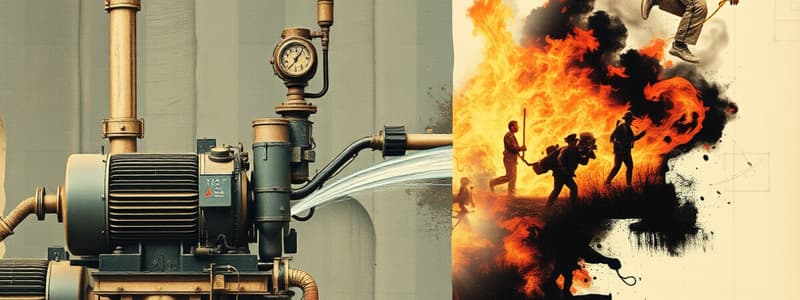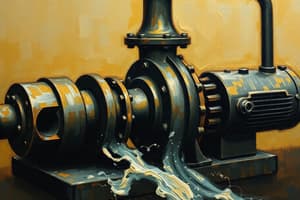Podcast
Questions and Answers
What is the first step the driver/operator should take when preparing the pump for operation?
What is the first step the driver/operator should take when preparing the pump for operation?
- Ensure the hose lines are connected securely.
- Adjust the throttle according to flow rates.
- Open the discharges to the hoses. (correct)
- Check the engine gauges for accuracy.
Why is it important to increase the throttle when starting the pump?
Why is it important to increase the throttle when starting the pump?
- To allow water to flow at high pressure immediately.
- To increase the pressure in the hoses and allow for effective pumping. (correct)
- To ensure the pump does not overheat during the setup process.
- To reduce the risk of air bleeding from the nozzle.
What should the driver/operator monitor once the pump is operational?
What should the driver/operator monitor once the pump is operational?
- The gauge readings associated with the engine and pump. (correct)
- The amount of fuel in the engine.
- The length of the hose lines in use.
- The water temperature in the hoses.
What might happen if the pump operates without water flowing for an extended period?
What might happen if the pump operates without water flowing for an extended period?
When adjusting the discharge pressure, when should the driver/operator reach the proper pressure?
When adjusting the discharge pressure, when should the driver/operator reach the proper pressure?
What can happen if the discharge flow volume from the fire pump is increased excessively?
What can happen if the discharge flow volume from the fire pump is increased excessively?
What is a potential consequence of pumping at a low residual pressure?
What is a potential consequence of pumping at a low residual pressure?
Which of the following statements about friction loss in the water system is correct?
Which of the following statements about friction loss in the water system is correct?
When connecting to a fire hydrant or supply hose, what is a critical pressure level to avoid?
When connecting to a fire hydrant or supply hose, what is a critical pressure level to avoid?
Why is it dangerous for the supply hose to collapse during operation?
Why is it dangerous for the supply hose to collapse during operation?
What is the first step a driver/operator should take when transitioning to an external water supply?
What is the first step a driver/operator should take when transitioning to an external water supply?
Why is it important to open the bleeder valve during the transition to an external water supply?
Why is it important to open the bleeder valve during the transition to an external water supply?
What should the driver/operator do to prevent pump cavitation when using the tank fill line?
What should the driver/operator do to prevent pump cavitation when using the tank fill line?
Which measure is NOT mentioned as a method for achieving cooling during pump operation?
Which measure is NOT mentioned as a method for achieving cooling during pump operation?
What is a critical task that the driver/operator must perform while monitoring the onboard tank?
What is a critical task that the driver/operator must perform while monitoring the onboard tank?
What is the purpose of using a flowmeter in this context?
What is the purpose of using a flowmeter in this context?
How can a driver/operator provide cooling without wasting water?
How can a driver/operator provide cooling without wasting water?
Which of the following actions should be taken when the water level in the onboard tank is low?
Which of the following actions should be taken when the water level in the onboard tank is low?
Flashcards are hidden until you start studying
Study Notes
Operating Fire Pumps
- Ensure the fire pump is operational before transitioning to an external water supply.
- Transition is necessary when water onboard is insufficient for the incident.
- External water sources may include fire hydrants, other apparatus, or static water sources.
Transition to External Water Supply
- Connect a supply line to an appropriate intake of the fire pump.
- Use an intake with a closed gate valve during operation to avoid air entering the system.
- Open the bleeder valve on the gated intake to purge air until a steady stream of water flows.
Booster Cooling and Water Circulation
- Open the booster cooling valve to recirculate water back into the tank.
- Use the tank fill line to maintain cooling, monitoring for potential pump cavitation.
- Partially open the valve (thumb distance) to minimize risk of cavitation while maintaining flow.
Monitoring Water Supply
- Continually check the water level in the onboard tank during operation.
- Estimate remaining water supply duration based on consumption rates and tank size.
- Communicate with personnel in dangerous areas about decreasing water levels to ensure safety.
Operating from a Pressurized Water Source
- Main pressurized supply sources are fire hydrants and hoses from other pumpers.
- Intake pressure may drop due to friction loss as discharge volume increases.
- Pumping below 20 psi (140 kPa) with supply from other apparatus poses risks of hose collapse and pump cavitation.
Studying That Suits You
Use AI to generate personalized quizzes and flashcards to suit your learning preferences.




